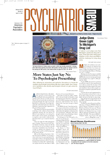A deeper understanding of the neurochemical processes underlying complex social behaviors is paving the way for advances in the field of psychiatry.
National Institute of Mental Health Director Thomas Insel, M.D., explained how at the annual meeting of the American Association of Directors of Psychiatric Residency Training (AADPRT) in March.
To emphasize the speed at which neuroscience is moving, Insel said, “residents in training 20 years from now will hear about dopamine and serotonin as historical neurotransmitters that may be important as modulators, but there will be others that don’t have a name right now—they are just numbers in a database—that will turn out to be critical” for discovering the roots of mental illness.
Insel described his research on two hormones implicated in social recognition and attachment in mammals—oxytocin and vasopressin.
He said that when mice meet one another, they spend about 2.5 minutes acquainting themselves—mostly by sniffing each other. This “getting to know you” time decreases by half when the mice are reintroduced.
But when Insel and his colleagues at Emory University genetically altered one of the mice to remove the gene for oxytocin and placed that mouse with a female mouse, upon reintroduction, he treated the female as if he were meeting her for the first time.
Oxytocin is associated with lactation, uterine contractions during birth, and maternal behavior in female mammals.
The research team injected low doses of oxytocin into the knockout mice and found that it decreased time spent socializing with familiar female mice.
The results of the study, “Social Amnesia in Mice Lacking the Oxytocin Gene” appeared in the July 2000 issue of Nature Genetics.
All mammals have a gene for oxytocin, and the researchers believe that defects in the gene could possibly contribute to symptoms of autism, schizophrenia, and other brain disorders characterized by social isolation.
Insel and his colleagues also studied the neuroscience of social attachment. To do so, he sought purely monogamous mammals as subjects—not an easy task.
Monogamy is a form of social organization found in only 3 percent of mammals, which may or may not include humans. “Depends on which human you’re talking about,” Insel joked.
The prairie vole, a palm-sized brown rodent, is a model of monogamy, Insel noted.
The researchers also studied the montane vole, which couldn’t be more different where monogamy is concerned.
Males and females don’t share nests and unite only briefly to mate. Insel said that the males have no interest at all in caring for their young and characterized the rodents, who are native to the Rocky Mountains, as “cowboys.”
The researchers quantified the voles’ social behavior with a series of partner-preference tests and found that mating was the key to the pair-bonding in prairie voles. “If they don’t mate, they can be placed together and there is no bond.”
The researchers theorized that during the mating process, oxytocin and another hormone, vasopressin, which is essential for the mate-guarding and paternal behavior in male mammals, flood a prairie vole’s brain.
The receptors for the hormones, he added, are located in parts of the brain that are important for reward and reinforcement—meaning that when the animal mates and the chemicals are released for the first time, the animal becomes “addicted” to its mate.
However, the researchers noted that after mating, montane voles did not develop the same partner preferences.
They discovered that this difference was not because montane voles didn’t release oxytocin or vasopressin during mating, but because the receptors for the hormones are located in different parts of the brain than they are in prairie voles.
When Insel and his colleagues looked at the structure of the vasopressin receptor genes for several species of voles, they found a difference in the DNA sequence in monogamous and nonmonogamous voles.
In the former, the scientists found a repetitive DNA sequence in the gene’s promoter region, an area that determines whether or not the gene is expressed.
In promiscuous voles like the montane, the gene’s promoter region was missing this repetitive sequence.
To test whether the repetitive sequence could account for differences in monogamy between the voles, the research team, led by Larry Young, Ph.D., incorporated the prairie vole vasopressin receptor gene into the genome of mice—who are not monogamous or particularly social.
The vasopressin receptors were distributed in a pattern that looked much like that of the prairie vole, Insel said, and this led to a change in the mouse’s behavior. “They didn’t become monogamous mice, but did become highly social when we gave them vasopressin.”
Insel said he hopes that the basic science—the animal studies—will help scientists identify neurotransmitters and neuromodulators that are implicated in disorders such as autism, where social behaviors are abnormal.
“We need to move the neuroscience of complex behaviors back into psychiatry,” Insel emphasized. “This is the beacon that will draw some of our best medical students into psychiatry and some of our best residents into research.” ▪

